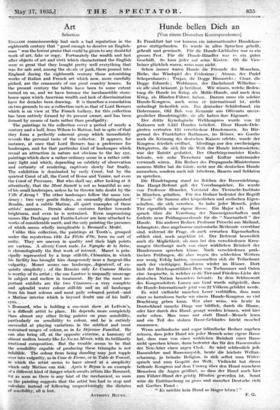Art
Selection
ENc.usn connoisseurship had such a bad reputation in the eighteenth century that " good enough to deceive an English- man " was the lowest praise that could be given to any doubtful work of art, fake or copy. Fortunately the wealth and lust after objects of art and virtu which characterized the English were so great that they bought pretty well everything that was for sale and, among the shoals of junk, there poured into England during the eighteenth century those astonishing works of Italian and French art which now, more carefully picked, are the ornaments of our great country houses. In the present century the tables -have been to some extent turned on us, and we have become the inexhaustible store- house upon which American wealth and lack of discrimination have for decades been drawing. It is therefore a consolation on two grounds to see a collection such as that of Lord Berners which is on view at The French Gallery, for this collection has been entirely formed by its present owner, and has been formed by means of taste rather than prodigality.
The paintings in. the collection cover a period of nearly a century and a half, from Wilson to Matisse, but in spite of that they form a perfectly coherent group which immediately reveals the personal taste of the collector. It appears, for instance, at once that Lord Berners has a- preference for landscapes, and for that particular kind of landscapes which reveal an attraction in nature not obvious to the lay eye, paintings which show a rather ordinary scene in a rather ordi- nary light and which, depending on subtlety of observation and certainty of rendering, captivate slowly but finally. The exhibition is dominated by early Corot, but by the quietest Corot of all, the Corot of Rome and. Venice, not even the Corot of Provence. But who shall say, after looking at it attentively, that the Mont Soraete is not as beautiful as any of his small landscapes, unless he be thrown into doubt by the Ville d'Avray? The other -landscapes follow the same ten- dency : two very gentle Sisleys, an unusually distinguished Boudin, and a subtle Matisse, all quiet examples of these artists' manners. Derain alone ventures further towards brightness, and even he is restrained. Even unpromising names like Daubigny and Fantin-Latour are here attached to works of considerable merit, and the only painting the presence of which seems wholly inexplicable is Besnard's Model..
Unlike this collection, the paintings at Tooth's, grouped under the mysterious_ title -La Fltehe d'Or, form no sort of unity. They are uneven in quality and their high points are various. A silvery_ Corot nude, La Nymphe de la Seine, is chronologically the first work of interest. Manet is prin- cipally represented by a large still-life, Clematites, in which his facility has brought him dangerously near a Sargent-like vulgarity. Monet scores one landscape, Argenteuil, of ex- quisite simplicity ; of the Renoirs only Le Costume Maria is Worthy of its artist ; the one Lautrec is unusually unsavage in subject and mellow in treatment. By far the most im- portant exhibits are the two Cezannes—a very complete and splendid water colour still-life and an oil landscape from his least solemn and most gaily coloured period—and a Matisse interior which is beyond doubt one of his bull's
eyes. •
.1 Bonnard, who is holding a one-man show at Lefevre's, is a difficult artist to place. He depends more completely than almost any other living painter on pure sensibility, particularly on sensibility to colour, and he is entirely successful at playing variations in the subtlest and most restrained ranges of colour, as in Le Dejeuner Familial. He can also bring off, at the opposite extreme, a harmony of almost molten beauty like Le Nit as Miroir, with its brilliantly irrational composition. But the trouble seems to be that the sensibility capable of producing these triumphs is not infallible. The colour from being dazzling may just topple over into vulgarity, as in Cour de Ferme, or in Table de Travail, in which the artist seems to have- aimed at a simplicity which only Matisse can risk. Apres le Repas is an example of a different kind of danger which awaits artists like Bonnard, for as soon as there -is any hint of the mechanical, as soon as the painting suggests that the artist has had to stop and calculate instead of following unquestioningly the dictates of sensibility, all is lost.
ANTHONY BLrXT.










































 Previous page
Previous page